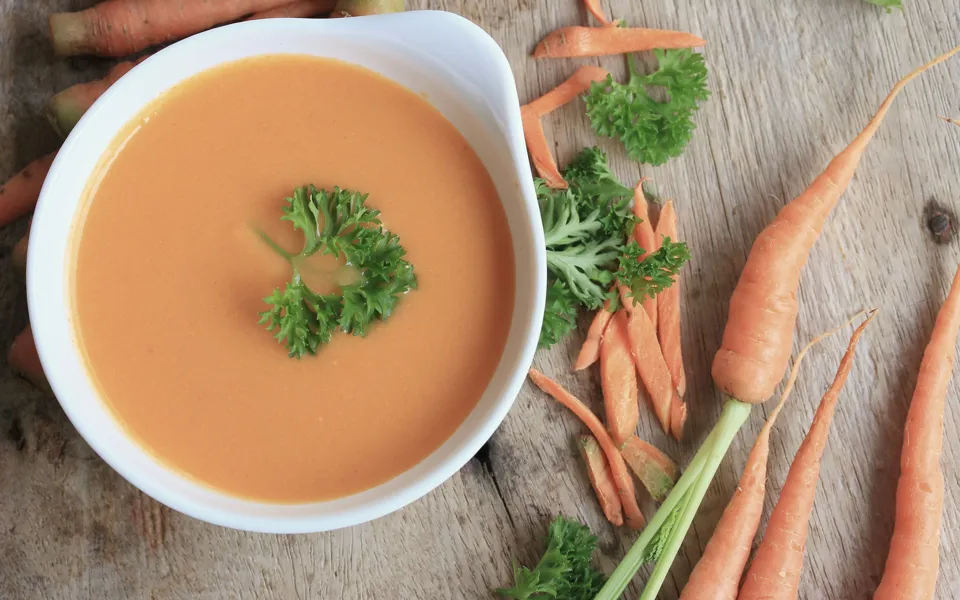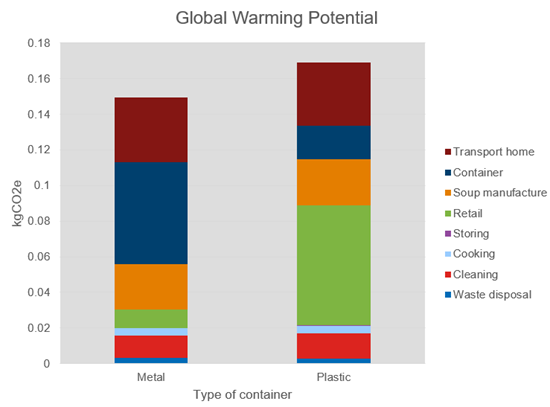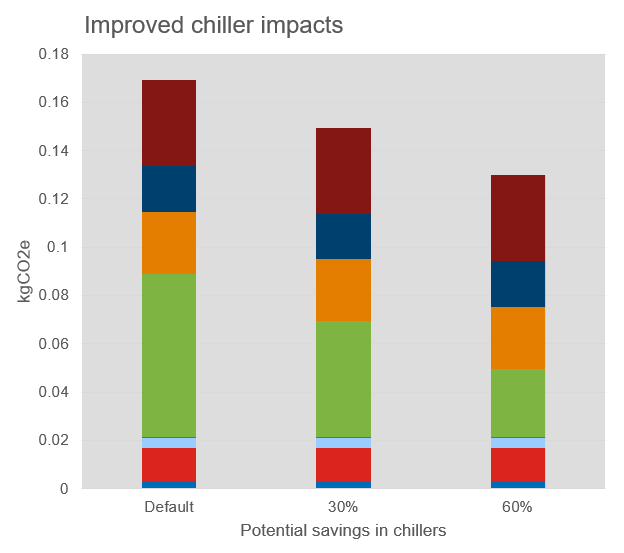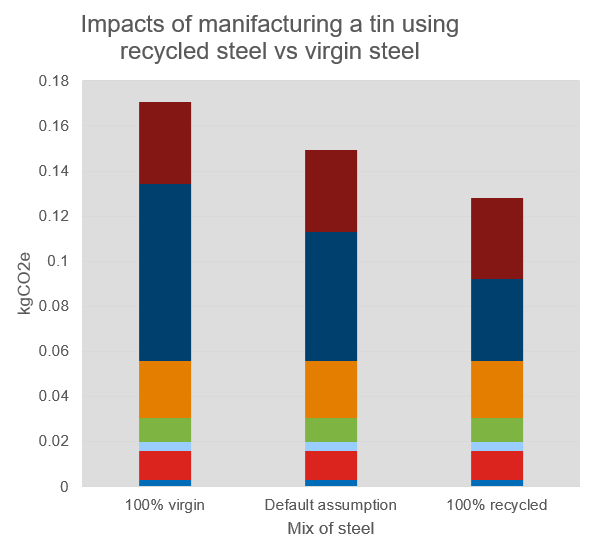
A tale of two soups – using life cycle assessment to identify environmental impact hotspots
21 Jul 2021
Tinned or tubbed? Which is the most sustainable way to buy your soup? Ricardo life cycle assessment (LCA) expert, Sam Hinton, has been assessing carrot soups to show us how LCAs work and what insights they can bring when comparing products’ sustainability.
It’s pleasing to say that sustainability is capturing people’s attention more than ever before. The world is pushing for greener vehicles, companies are aligning themselves to the UN’s Sustainable Development Goals and consumers are showing increasing awareness of the impacts of their purchases.
One area of particular interest for consumers is around plastics and their potential for pollution. A friend of mine recently took to social media to criticise their favourite soup brand for only selling its soup in plastic tubs rather than metal cans.
This got me wondering – is soup in a metal container actually better for the environment than soup in a plastic container?
Once you start thinking about it, the choice has ramifications across the life cycle of soup. Soup in plastic tubs tends to be refrigerated in shops and in the home, whereas tinned soup lives on a shelf and in a cupboard. Soup from a plastic tub can be microwaved in its packaging, but soup from a metal tin must be dispensed before cooking. And, of course, once used, metal cans have higher recycling rates than plastic.
As LCA practitioners, you won’t be surprised to hear that we believe the best way to account for a product’s environmental impacts is to undertake a cradle-to-grave assessment, considering the impacts of producing, shipping, storing, using and disposing of a product. Only in this way can we make an informed decision that avoids shifting environmental harms from one area (say disposal at end of life) to another (say manufacturing).
So, how do you analyse the life cycle of carrot soup?
We designed an LCA model in SimaPro® (LCA software) to assess:
- Producing carrot soup.
- Manufacturing metal and plastic containers for the soup.
- Distributing the soup to retailers and storing it in chilled and ambient sections of a shop.
- Travelling from a shop to the home.
- Storing the soup at home.
- Heating the soup at home.
- Cleaning and disposing of the containers.
I will refrain from going into all the details (but please do ask me if you’re curious), but I think it’s helpful to know some key assumptions:
| Plastic container | Metal container | |
|---|---|---|
| Weight of soup | 600g | 400g |
| Weight of container | 16g | 47g |
What did the LCA show?
Assuming an average serving of 200g cooked via microwave, we found that the soup in a plastic container had a global warming potential (GWP) of 0.17kg of carbon dioxide equivalent (CO2e) per bowl, whereas the soup in a metal container had an impact of 0.15kg CO2e per bowl.
In the figure below, you can see the impacts of both types of containers, broken down by product stage. For metal containers, the biggest impact arises in the production of the container. However, the impact of the plastic container is relatively small. This is because, by weight, less plastic is needed per container and its GWP per kg is less impactful compared to steel. However, the retail impact of the plastic container is far higher because the product needs to be stored in a shop’s refrigerated section. On this initial pass of the results, it appears that the metal container is preferable to the plastic container – at least in terms of climate change.

What about waste?
You may be thinking, it’s all very well talking about climate change, but what about plastic waste? This is a fair criticism. Climate change is not synonymous with environmental impacts and this is a key reason why an LCA assesses a wide range of indicators (our preferred list covers 14 environmental issues).
In terms of waste, 23.5g of steel waste and 5.3g of plastic waste are produced per serving of soup. We have assumed that both types of container are placed in domestic mixed recycling after use. Once collected by the local authority, we have assumed that 98% of the steel waste is recycled, with the remainder being treated via energy recovery, whereas 48% of the plastic waste is sent to landfill, 2% to energy recovery and just 50% recycled. Of the 50% that is recycled, we have assumed 33% is recycled in the UK and 67% is exported to Turkey, Malaysia, and Poland – for overseas recycling, we have applied some average global values. This equates to 1.8g of plastic waste per serving is disposed of outside the UK.
Based on this initial analysis, the plastic container appears to be worse in terms of climate change and waste generation.
Testing our LCA assumptions
The initial results above are helpful, but it is always important to test assumptions. The retail impacts, which are key for the plastic scenario, are based on two figures for the GWP/£ spent on ambient and chilled goods. It is fair to say that supermarkets are becoming more aware of the impact of chillers and it is more common to see enclosed units that are more energy efficient with fewer refrigerant leaks.
A quick search of my local supermarket’s plans reveals that new units are being rolled out that can save between 30% and 60% of the GWP of its existing cabinets. When this broad-brush reduction is applied to my original assumptions, the GWP of the soup in a plastic container reduces to between 0.13 and 0.15kgCO2e/serving – which is preferable to the tinned soup.

For soup in a metal tin, the hotspot was not in the shop, but in manufacturing the metal can. Our default assumption used an average mix of steel that was 57% virgin steel and 43% recycled. This begs the question – what if we only make soup cans out of recycled steel?
The chart below compares our default scenario with two alternative scenarios where the tin was made from 100% virgin steel or 100% recycled steel. Unsurprisingly, the 100% recycled steel is preferable to our default assumption, representing a reduction in its GWP of 14% per serving. Its total impact was found to be 0.13kgCO2e per serving, which is the same as that for the soup sold in a state-of-the-art refrigeration unit.
 However, these are just a few scenarios. As a team, we discussed how we cook our soup and there were quite a range of options – some would use a gas hob, others would microwave it in a glass container before putting it in a bowl. Furthermore, some would rinse the containers before recycling them, some would use a dishwasher. We were able to include all of these variables in our model, which provided some interesting results (please do get in touch if you want to see how the results change for gas hob use).
However, these are just a few scenarios. As a team, we discussed how we cook our soup and there were quite a range of options – some would use a gas hob, others would microwave it in a glass container before putting it in a bowl. Furthermore, some would rinse the containers before recycling them, some would use a dishwasher. We were able to include all of these variables in our model, which provided some interesting results (please do get in touch if you want to see how the results change for gas hob use).
If we assume that everyone cooks the soup in the same way, these decisions do not particularly matter. However, our anecdotal discussion suggests the soups are not cooked in the same way. As we chase savings in our metal container and refrigeration unit, these seemingly minor decisions about how consumers treat the two types of soup differently do become material considerations.
What does all this really mean?
As I mentioned at the outset of this blog, LCA is a great method for considering the various decisions that occur throughout a product’s life cycle so as to avoid burden shifting. This small study has shown that manufacturing a metal container has a greater GWP than that for making a plastic container, but that the move to plastic places a higher burden on the retail stage and results in 1.8g of plastic waste leaving the UK per serving.
A product LCA cannot tell us whether this plastic waste is a greater concern than climate change. However, the takeaway point for me is that, given my supermarket is not using enclosed state-of-the-art chillers, its chilled soup is worse in terms of waste and climate change – and I will not be putting it in my shopping basket.
While the findings of my LCA are specific to the soup I purchased at my local supermarket, the method is applicable to any product. The answer to comparative LCAs is inevitably ‘it depends’, but it does show us:
-
When and where it depends.
-
How much of a difference it makes.
-
What we can do to avoid the hotspots.
At Ricardo, we conduct LCAs for a wide variety of organisations across many sectors. This enables our clients to develop a deeper knowledge of their products in comparison to others on the market and shows them where the most effective changes can be made to improve sustainability. Our deep scientific analysis is helping our clients develop more sustainable products and/or demonstrate their already impressive environmental credentials - so satisfying investors, customers, and other stakeholders.




 Follow Ricardo plc for regular updates
Follow Ricardo plc for regular updates





